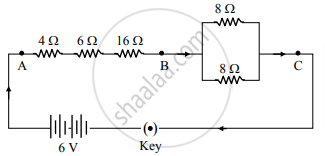Advertisements
Advertisements
Question
A current of 2 A is passed through a coil of resistance 75 Ω for 2 minutes.
(a) How much heat energy is produced?
(b) How much charge is passed through the resistance?
Solution
Given , current (I) = 2 A
Resistance R = 75 Ω
Time , t = 2 min = 120 s
(a) Heat produced , H = I2Rt
or , H = (2)2 (75)(120) J = 36000 J
(b) Charge passed , Q = It
or, Q = (2)(120) C = 240 C
APPEARS IN
RELATED QUESTIONS
With a neat labelled diagram and derive the equation for three resistances connected in parallel.
Which of the following arrangement, A or B, has the lower combined resistance?

Two resistors having resistance 4𝛀 and 6𝛀 are connected in parallel. Find their equivalent resistance.
A particular resistance wire has a resistance of 3 ohm per meter. Find the total resistance of three lengths of this wire each 1.5 m long, joined in parallel.
A battery of e.m.f. 15 V and internal resistance 2 `Omega` is connected to tvvo resistors of 4 ohm and 6 ohm joined.
(i) In series,
(ii) In para 1 lel. Find in each case the electrica I energy spent per minute in 6 ohm resistor.
An electrical appliance having a resistance of 200 Ω is operated at 200 V. Calculate the energy consumed by the appliance in 5 minutes in kWh.
A given wire is stretched to double its length. How will its resistance change?
What connection is used in domestic appliances and why?
Study the following circuit:

On the basis of this circuit, answer the following questions:
i. Find the value of total resistance between the points A and B.
ii. Find the resistance between the points B and C.
iii. Calculate the current drawn from the battery, when the key is closed
OR
iii. In the above circuit, the 16Ω resistor or the parallel combination of two resistors of 8 Ω, which one of the two will have more potential difference across its two ends? Justify your answer.
